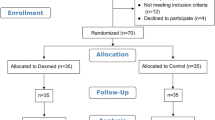Abstract
Purpose. Tracheal intubation using a lightwand device (Trachlight) should minimize hemodynamic change by avoiding direct-vision laryngoscopy. We evaluated hemodynamic and catecholamine responses during tracheal intubation using a Trachlight in elderly patients with hypertension.
Methods. Twenty-six hypertensive patients aged over 65 years undergoing orthopedic surgery were randomly divided into two groups, group L (n = 13) and group T (n = 13). Anesthesia was induced with fentanyl (2 Μg · kg−1) and propofol (1.5 mg · kg−1), and then muscle relaxation was obtained with vecuronium (0.15 mg · kg−1). The trachea was intubated with either a Macintosh laryngoscope (group L) or a Trachlight (group T). Hemodynamics, plasma catecholamine concentrations, and arterial blood gases were measured before the induction of anesthesia (T0), before tracheal intubation (T1), immediately after tracheal intubation (T2), and 3 min after tracheal intubation (T3).
Results. The intubation time was shorter in group T than in group L (12.6 ± 1.7 vs 23.5 ± 2.9 s, mean ± SE; P ≪ 0.01). Compared with the preinduction (T0) value, systolic blood pressure (SBP) showed a significant decrease at T1 and T3 in group L and at T1, T2, and T3 in group T. The heart rate (HR) and plasma norepinephrine (NE) concentration showed no change in either group throughout the time course, whereas the plasma epinephrine (E) concentration showed a significant decrease at T2 and T3 in both groups. The mean values of the rate-pressure product (RPP: HR × SBP) were less than 15 000 after tracheal intubation in both groups. There was no significant difference in hemodynamic or catecholamine responses between groups at any point. No patient had ischemic ST-T changes in either group.
Conclusion. A lightwand has no advantage over a laryngoscope in terms of hemodynamic and plasma catecholamine responses to tracheal intubation in elderly patients with hypertension, despite a shorter intubation time.
Similar content being viewed by others
Author information
Authors and Affiliations
About this article
Cite this article
Kanaide, M., Fukusaki, M., Tamura, S. et al. Hemodynamic and catecholamine responses during tracheal intubation using a lightwand device (Trachlight) in elderly patients with hypertension. J Anesth 17, 161–165 (2003). https://doi.org/10.1007/s00540-003-0166-8
Received:
Accepted:
Issue Date:
DOI: https://doi.org/10.1007/s00540-003-0166-8




